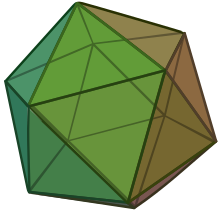20 (bilang)
- Para sa ibang gamit, tingnan 20 (paglilinaw).
| ||||
|---|---|---|---|---|
← 20 21 22 23 24 25 26 27 28 29 → | ||||
| Kardinal | dalawampu | |||
| Ordinal | ika-20 (ikadalawampu) | |||
| Numerasyon | bigesimal | |||
| Paktorisasyon | 22 × 5 | |||
| Mga panghati | 1, 2, 4, 5, 10, 20 | |||
| Griyegong pamilang | Κ´ | |||
| Romanong pamilang | XX | |||
| Binaryo | 101002 | |||
| Ternaryo | 2023 | |||
| Oktal | 248 | |||
| Duwodesimal | 1812 | |||
| Heksadesimal | 1416 | |||
Ang 20 (dalawampu) ay isang likas na bilang at bilang rasyonal na pagkatapos ng 19 at bago ng 21.
Sa matematika
[baguhin | baguhin ang wikitext]
- Isang pronikong bilang ang 20.[1]
- Isang tetrahedrikong bilang ang 20 bilang 1, 4, 10, 20.[2]
- Batay ang 20 para sa sistemang bilang na bigesimal.[3]
- Ang 20 ay ang ikatlong numerong kompuwesto na produkto ng isang kinuwadradong pangunahin at isang pangunahin, at ito din ang ikalawang kasapi ng (22)q na pamilya sa anyong ito.
- Ang 20 ay ang pinakamaliit na primitibong masaganang bilang.[4]
- May 20 mukha ang isang icosahedron.[5] May 20 vertex ang dodecahedron.[6]
- Maaring isulat ang 20 bilang ang kabuuan ng tatlong bilang na Fibonacci na natatangi, i.e. 20 = 13 + 5 + 2.[7]
Mga sanggunian
[baguhin | baguhin ang wikitext]- ↑ "Sloane's A002378: Pronic numbers". The On-Line Encyclopedia of Integer Sequences. OEIS Foundation. Nakuha noong 2020-11-30.
((cite web)): CS1 maint: date auto-translated (link) - ↑ "Sloane's A000292 : Tetrahedral numbers". The On-Line Encyclopedia of Integer Sequences (sa wikang Ingles). OEIS Foundation. Nakuha noong 2016-05-31.
((cite web)): CS1 maint: date auto-translated (link) - ↑ Weisstein, Eric W. "Vigesimal". mathworld.wolfram.com (sa wikang Ingles). Nakuha noong 2020-08-16.
((cite web)): CS1 maint: date auto-translated (link) - ↑ "Sloane's A071395 : Primitive abundant numbers". The On-Line Encyclopedia of Integer Sequences (sa wikang Ingles). OEIS Foundation. Nakuha noong 2016-05-31.
((cite web)): CS1 maint: date auto-translated (link) - ↑ Weisstein, Eric W. "Icosahedron". mathworld.wolfram.com (sa wikang Ingles). Nakuha noong 2020-08-16.
((cite web)): CS1 maint: date auto-translated (link) - ↑ Weisstein, Eric W. "Dodecahedron". mathworld.wolfram.com (sa wikang Ingles). Nakuha noong 2020-08-16.
((cite web)): CS1 maint: date auto-translated (link) - ↑ Dunlap, R. A. (1997). The Golden Ratio and Fibonacci Numbers (sa wikang Ingles). World Scientific. pp. 72–73. ISBN 978-981-238-630-4.
((cite book)): CS1 maint: date auto-translated (link)
![]() Ang lathalaing ito na tungkol sa Bilang ay isang usbong. Makatutulong ka sa Wikipedia sa pagpapalawig nito.
Ang lathalaing ito na tungkol sa Bilang ay isang usbong. Makatutulong ka sa Wikipedia sa pagpapalawig nito.
Text is available under the CC BY-SA 4.0 license; additional terms may apply.
Images, videos and audio are available under their respective licenses.
